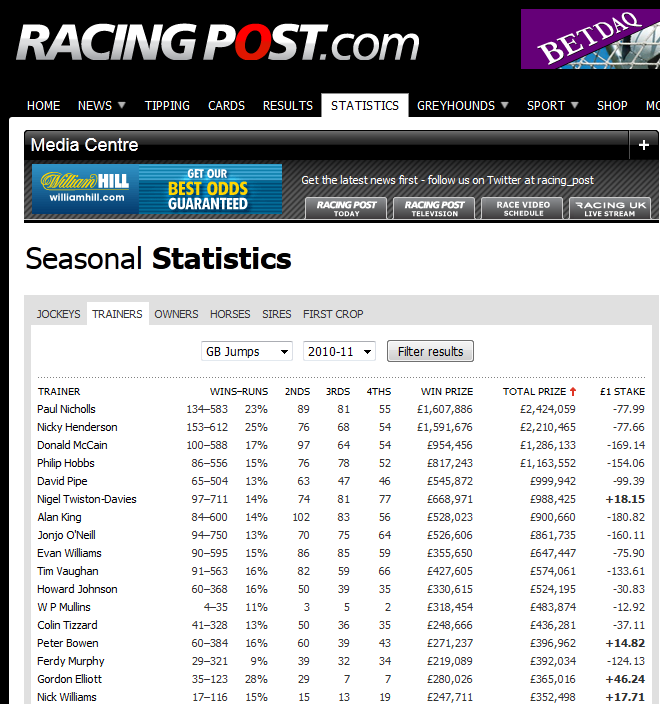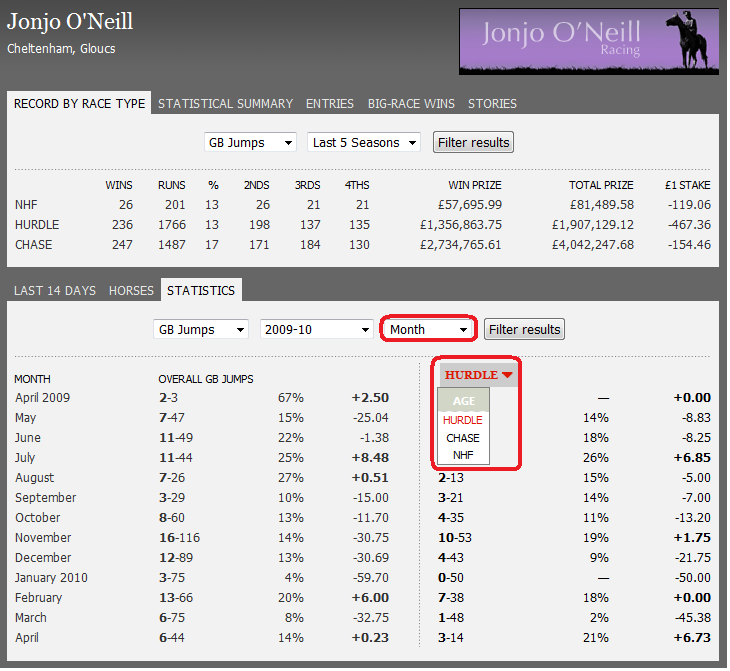Why Well-Known Trainer Trends Are Un-Profitable (and what you can do about it)
October 26, 2011 by Jonathan
Filed under Horse Racing, Recent Articles
Punters who pay close attention to trainer methods can identify profitable angles. In this article we look at “Trainer Trends” and provide you with a set of core principles to help you focus on areas of their racing statistics that are likely to produce profits.
Trainer trends
Trainers are creatures of habit and they target various courses of big prize money races each year. The top yards attract the best horses from the wealthiest owners and can have as many as 200 horses in training, which ultimately gives them a far greater edge over the smaller yards.
Backing their horses can provide an alternative to conventional form reading, although you do need to be selective when taking this approach because, due to the ever increasing availability of accurate horse racing statistics available to punters no profit can be obtained following the general trainer trends published in the racing media.
Most of the established trends are well-recognized and over bet by the punting masses. Even new, profitable statistics quickly become unprofitable once publicized.
It`s the herd mentality of inexperienced punters backing high strike rate trainer jockey combinations almost blindly, which causes the bookmakers to offer absurdly low prices on the stables which consistently maintain high strike rates each year.
The key question is how do you get around these inherent problems?
Well, there are various different approaches you can take. So, with this in mind we have devised a set of core principles which will help you to focus on specific areas of trainer statistics that are likely to yield profits.
High Strike rates rarely = PROFITS
Firstly, trainer strike rates and percentages need to be put into context. Each Jumps trainer will have achieved his overall winning percentages in five different race types:
- Non handicap hurdles & chases
- Handicap hurdles & chases
- National Hunt Flat races
The overall win percentages will never be even across all race types or age groups? You need to assess which group the profitable angles have been achieved in. A trainer may have a recorded a level stakes profit in non-handicaps for example, but a big loss in handicaps, or with older horses.
Focusing on individual trainer strike rates for specific types of runners will always be more profitable than assessing their overall strike rates for all race types. Other angles include assessing a trainer`s runners by:
- age
- distance
- course
- month
Although we have provided you with some guidelines to follow you still need to be a little flexible at times, and on occasions there will be exceptions to the rule, for example;
If you identify a trainer who makes a profit at a particular course with his novice hurdler’s and then discover another trainer also makes a decent level stakes profit at the course, with his novice hurdlers. In this situation it would be wise to consider betting on both trainers runners.
Avoid well-known trends
Instead of following well known media assumptions regarding trainer trends, investigate profitable angles using the free Racing Post Seasonal Statistics tool. Avoid looking at established patterns that everyone else knows about.
Specialise
No one can possibly hope to cover every possible profitable trend for every trainer. Its far more productive to focus on about 5 to 10 trainers each season. Remember all trainers manage their horses in different ways – focusing on certain types of races at certain times of the year.
Big stables aim their better class animals on primary and big race meetings during the year.
Some of the smaller stables can be very profitable to follow, although in general you will back plenty of losers before hitting the elusive 20/1 shot. You can use the Racing Post seasonal statistics table initially, to find trainers that have recorded a level stakthees profit.
Once you’ve identified several, it’s worth digging a little deeper to get a breakdown of how this profit was achieved. For example a small yard may be showing a level stakes profit of +20 points, but after further investigation you may discover there were only three winners with odds of 14/1/, 16/1 and 20/1 from lots of runners.
Basically, this profit is unlikely to be repeated and the high odds winners give a false representation of the level stakes profit achieved, therefore should not be considered a trend to follow.
Statistics sample size
You do need to follow reasonable sample sizes of data for them to be effective. For example if you take a look at the screenshot of Jonjo O’Neill’s monthly statistics below, you’ll notice that in April 2009 he recorded 67% strike rate.
Closer inspection of this statistic clearly shows there were only three runners of which two won. This sample size is far too small to consider as reliable, instead you should look to assess data when there has been a minimum of about 40 races run for a particular month, race type, course or distance.
It’s also worth bearing in mind that an individual years stats can falsely skew the five-year profit and loss figures. For example a trainer may have recorded a 50 point profit at a particular course two years ago, but over the last two years recorded a loss at the same course.
The outcome being that the overall statistics may still show a profit for the trainers runners at that particular course, when in actual fact all of the winners were achieved in one particular year, and all other years before and after the profitable year, clearly show a loss.
Ideally you should look to identify more than one profitable year for a particular statistic. You can do this by using the drop-down box to select each year and then clicking filter results within the five-year dataset.
Winning and losing patterns
Bear in mind stable form changes throughout the season, therefore it is subject to both losing and winning patterns. Trainer statistics change each week, month and year, ultimately they are not set in concrete. Evaluation of current monthly performance will only be accurate if monitored regularly. Always be flexible and prepared to change your point of view.
Conclusion
We have provided you with a set of core principles to help focus on areas of trainer statistics that are likely to yield profits. Punters who pay close attention to these can identify profitable angles.
Although, you must remain objective at all times and not be tempted to back horses blindly simply because they come from a specific yard. You must be confident that you are selecting a particular horse because there is evidence that it fits a winning profile/trend you have uncovered.
We can appreciate that not everyone will want to research profitable trainer statistics, with this in mind we can recommend a professional service which does exactly this. False – favourites members club is a betting advisory service provided by the well respected Jonathan Burgess (false favourites.co.uk) and top trainer trends analyst Jonathan Sutcliffe (A.J.racing)
Resources
>>>download “How to profit from trainer statistics” PDF absolutely FREE<<<
This guide is designed to help you find profitable backing and laying angles through assessing – National Hunt Trainer statistics. Doing this will give you a big advantage over the punting masses who generally ignore information that requires any effort to uncover.
Once you have used the simple but effective methods described in the PDF a few times, they will only take minutes to put into practice. Even better the same generic principles can be used to assess any, Flat or All Weather trainer’s statistics using the Racing Post.com; thus making it a truly profitable resource to have in your betting portfolio.
Learn how to make realistic profits from betting
Practical, profitable advise direct to your inbox
- Proven techniques I use in my own betting
- Honest reviews on systems and services that are profitable
- Exclusive tips to make your betting easier & more profitable
 Copyright secured by Digiprove � 2010 Jonathan Burgess
Copyright secured by Digiprove � 2010 Jonathan Burgess











Comments
One Response to “Why Well-Known Trainer Trends Are Un-Profitable (and what you can do about it)”Trackbacks
Check out what others are saying about this post...[…] For example John Gosden`s stables are based in Newmarket and his runners have been profitable to follow at the Newmarket racecourse over the last five seasons (winners 36 -247 strike rate 15% profit and loss +43.68) Read our essential guide to making a profit from backing and Laying trainer trends […]